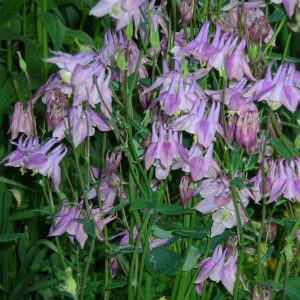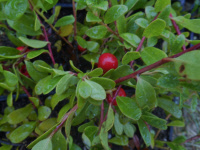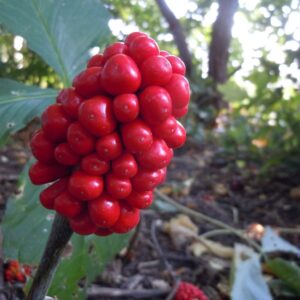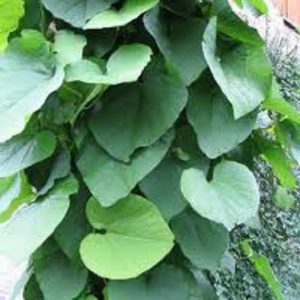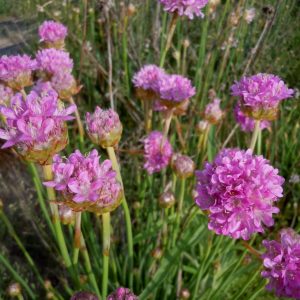Our Plants
Showing 49–56 of 587 results
-
Aquilegia vulgaris Columbine, Granny’s bonnet Z 3-10
May to June purple, blue, red, pink or white cluster of dangling, bell-shaped petals flaring at the ends, held aloft by upright, arching stems.
May to June purple, blue, red, pink or white cluster of dangling, bell-shaped petals flaring at the ends, held aloft by upright, arching stems
Size: 36”x 18”
Care: Sun or part shade fertile moist well-drained soil
Native: EuropeVery ancient plant. Used medicinally in Middle Ages to cure pestilence, measles, small pox and jaundice and remove obstructions of the liver but large doses are poisonous. Aquilegia was mentioned in the literature of Chaucer and Shakespeare. It was a popular Elizabethan (Elizabeth I in the late 1500’s) cottage garden flower. French botanist Tournefort reported that women used the seeds to “drive out the Measles and Small Pox.” John Winthrop introduced this plant to the New World in the 1630’s. White form by 1600’s. Cultivated in America since 1700’s.
Double form: Aquilegia vulgaris var. plena Grown at America’s 1st botanic garden, Elgin Botanic Garden 1811. Described by L.H. Bailey as of garden origin with “flowers much doubled, ranging from white to deep blue.” (1933)
-
Arcanthemum articum Arctic daisy Z 3- ?
Closely-packed groundcover like a rug of small, classic white daisies with yellow centers.
Closely-packed groundcover like a rug of small, classic white daisies with yellow centers.
Size: 6-18” x spreading
Care: sun to part shade in moist well-drained to well-drained soil
Native: Western Canada to Alaska, North-east Europe to Japan
Wildlife Value: drought tolerantBy 1735
-
Arctostaphylos uva-ursi Bearberry, Bear’s grape, Kinnikinnick Z 2-7
In spring fragrant, pinkish-white bell-shaped flowers, evergreen, glossy foliage and Marlboro red berries in fall.
OUT OF STOCK
“Dwarf ornamental shrub, ornamental in foliage, flowers and berry.” Rand 1866. In spring fragrant, pinkish-white bell-shaped flowers, evergreen, glossy foliage and Marlboro red berries in fall. Great for cascading over edge of wall or groundcover.
Size: 4” x 20” forms dense groundcover over time. Stems root to spread.
Care: sun to part shade in moist well-drained to dry, acidic soil. Needs watering until established. Best grown with protection from wind.
Native: No. America, Wisconsin native
Wildlife Value: Host for several butterfly species including Hoary Elfin, Brown Elfin and Freija Fritillary.
Awards: Cary Award Distinctive Plants for New EnglandKinnikinnick is Algonquin meaning “mixture.” Used as an ingredient in Native American smoke mixtures. For centuries leaves used to make medicinal tea as a tonic and diuretic in many parts of the world. Cheyenne drank the tea to cure back sprains. Some Native Americans used it to cure venereal disease, others to cure pimples and itching, peeling skin. Both Indians and colonists mixed leaves with tobacco for smoking. Collected by Meriwether Lewis on the Expedition.
-
Arisaema dracontium syn. Arum dracontium Green dragon, Dragon root Z 4-9 POISON
A greenish, long-tipped spadix (the "dragon’s tongue") grows several inches beyond a narrow green spathe, a narrow, greenish, hooded, cylinder. Numerous tiny flowers crowd onto the 6-inch-long flower stem. Tiny white flowers in spring turn into a spike of red berries in fall.
OUT OF STOCK
A greenish, long-tipped spadix (the “dragon’s tongue”) grows several inches beyond a narrow green spathe, a narrow, greenish, hooded, cylinder. Numerous tiny flowers crowd onto the 6-inch-long flower stem. Tiny white flowers in spring turn into a spike of red berries in fall.
Size: 1-3’ x 6-8”
Care: part-shade to shade in moist, slightly acidic soil
Native: NH to Florida, west to TX, north to MN. Wisconsin native
Wildlife Value: Deer resistant. Although poison to humans, birds, wild turkeys and wood thrush as well as some mammals eat the berries.Named by 1753. Arisaema, is Greek for “blood arum” or “red arum”. Dracontium, means “of the dragon” in Latin. Named for the resemblance of the spadix to the tongue of a dragon. For the Menominee sacred bundles of the roots and gave the owner the power of supernatural dreams.
-
Arisaema triphyllum Jack-in-the-pulpit, Indian turnip Z 4-9
May-June striped, hooded spathe (leaf-like bract shielding one side of the upright spike), red berries in fall
OUT OF STOCK
May-June striped, hooded spathe (leaf-like bract shielding one side of the upright spike), red berries in fall – a favorite shade plant
Size: 6-24”x 12”
Care: Part shade - shade in moist soil
Native: Eastern No. America, Wisconsin native.Pawnee medicine men pulverized the corm to treat headaches and rheumatism. The Cherokee used it to cure headaches, the common cold, ringworm, boils and “for scald head (and) scrofulous sores.” Iroquois remedied adolescent diarrhea and listless infants with Jack-in-the-pulpit. Also “for nonconception caused by cold blood” and for “temporary sterility.” Chopped root mixed with whiskey cured colds. It induced pregnancy for female horses. Menominee pulverized the root, placed in incised lip to counteract witchery on the face. The seed predicted death or recovery for the Meskwaki who also used it as poison to kill enemies. The Potawatomi discovered that cooking the root for 3 days eliminated the poison. HoChunk spread a compound of the root on neuralgia or rheumatism. Native Americans boiled the berries and roasted the root, for food. Garden cultivation since 1664.
**LISTED AS OUT OF STOCK BECAUSE WE DO NOT SHIP THIS ITEM. IT IS AVAILABLE FOR PURCHASE AT OUR RETAIL LOCATION.
-
Aristolochia durior syn. A. macrophylla, A sipho Dutchman’s pipe, Birthwort Z 4-8
Yellow, mottled brown flowers like Meerschaum pipes in May – June, mostly grown for heart-shaped leaves on this vigorous climber (climbs by twining). Perfect for creating a screen on pergolas, arbors and fences.
OUT OF STOCK
Yellow, mottled brown flowers like Meerschaum pipes in May – June, mostly grown for heart-shaped leaves on this vigorous climber (climbs by twining). Perfect for creating a screen on pergolas, arbors and fences.
Size: 20-30’ x 2’ at ground, 20’ on top.
Care: sun to shade (one of few vines for shade) in moist well-drained to moist soil. Prune to encourage branching.
Native: Maine to Georgia, west to KS.
Wildlife Value: sole host for the Pipevine swallowtail butterflyAristolochia is Greek for easing childbirth. Cherokee applied decoction of root for swollen legs & feet. Collected by Colonial nurseryman John Bartram and sent to England in 1763. Sold in America’s 1st plant catalog, Bartram’s Broadside, 1783. In Colonial and Victorian gardens, popular vine to create privacy and shade
-
Armeria maritima Thrift, Sea pink Z 3-10
Petite pink balls from May to June atop grass-like foliage
Petite pink balls from May to June atop grass-like foliage
Size: 8” x 12”
Care: full sun, well-drained, moderately fertile soil
Native: North Atlantic coastsKnown to grow in the late Glacial period – around 10,000 BC. Common cottage garden flower since the reign of Queen Elizabeth 1st, 16th century. A favorite plant for knot gardens.
-
Armeria pseudoarmeria syn. A. formosa syn. A. latifolia, A. alpina Alpine thrift, Giant thrift Z 5-7
Carmine-pink balls atop stems and taller than grass-like foliage flowering in June and sporadically all summer
OUT OF STOCK
Carmine-pink balls atop stems and taller than grass-like foliage flowering in June and sporadically all summer
Size: 12” x 8”
Care: full sun in well-drained soil, heat and drought tolerant
Native: So. EuropeIn gardens since 1740. Per Wm Robinson this plant: “one of the best hardy flowers from southern Europe and should be in every collection.”

